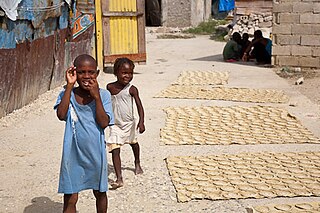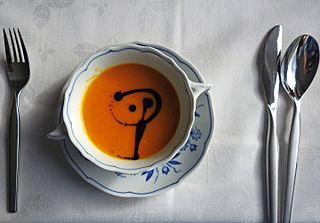 W
WHaitian cuisine consists of cooking traditions and practices from Haiti. It is a Creole cuisine, that originates from a blend of several culinary styles that populated the western portion of the island of Hispaniola, namely the African, French, indigenous Taíno, Spanish and Arab influence. Haitian cuisine is comparable to that of "criollo" cooking and similar to the rest of the Latin Caribbean, but differs in several ways from its regional counterparts.
 W
WTostones are twice-fried plantain slices commonly found in Latin American cuisine and Caribbean cuisine. Most commonly known as tostones, Puerto Rico, Jamaica, Nicaragua, Cuba, Honduras and Venezuela, they are also known as tachinos or chatinos (Cuba), platano frito or frito verde, bananes pesées (Haiti), patacones and, sometimes, patacón pisao in Colombia.
 W
WBarbecue or barbeque is a term used with significant regional and national variations to describe various cooking methods which use live fire and smoke to cook the food. The term is also generally applied to the devices associated with those methods, the broader cuisines that these methods produce, and the meals or gatherings at which this style of food is cooked and served. The cooking methods associated with barbecuing vary significantly but most involve outdoor cooking.
 W
WChayote, also known as mirliton, güisquil, pimpinela and choko, is an edible plant belonging to the gourd family, Cucurbitaceae. This fruit was first cultivated in the Mesoamericas between southern Mexico and Honduras, with the most genetic diversity available in both Mexico and Guatemala. It is one of the several foods introduced to the Old World during the Columbian Exchange. Also during this period, the plant spread from to other parts of the Americas, ultimately causing it to be integrated into the cuisine of many other Latin American nations.
 W
WCooking bananas are banana cultivars in the genus Musa whose fruits are generally used in cooking. They may be eaten ripe or unripe and are generally starchy. Many cooking bananas are referred to as plantains or green bananas. In botanical usage, the term "plantain" is used only for true plantains, while other starchy cultivars used for cooking are called "cooking bananas". True plantains are cultivars belonging to the AAB Group, while cooking bananas are any cultivars belonging to AAB, AAA, ABB, or BBB groups. The currently accepted scientific name for all such cultivars in these groups is Musa × paradisiaca. Fe'i bananas from the Pacific Islands are often eaten roasted or boiled, and are thus informally referred to as "mountain plantains," but they do not belong to any of the species from which all modern banana cultivars are descended.
 W
WEpis is a blend of peppers, garlic, and herbs that is used as a flavor base for many foods in Haitian cuisine. Some refer to it as a pesto sauce. It is also known as epise and zepis.
 W
WGriot is a dish in Haitian cuisine. It consists of pork shoulder marinated in citrus, which is braised and then fried. It is commonly served at parties. Griot along with diri ak pwa wouj is considered by some to be Haiti's "national dish."
 W
WA Haitian patty is a baked puff pastry-type pastry filled with savoury filling.
 W
WMaggi is an international brand of seasonings, instant soups, and noodles that originated in Switzerland in the late 19th century. The Maggi company was acquired by Nestlé in 1947.
 W
WA mud cookie, or bonbon tè in Haitian Creole, is a food that is eaten in Haiti, particularly during pregnancy. They can be found in slums like Cité Soleil. Dirt is collected from the nation's central plateau, near the town of Hinche, and trucked over to the market where women purchase it. It is processed into cookies in shanty towns such as Fort Dimanche. First, the dirt is strained to remove rocks and clumps. The dirt is mixed with salt and vegetable shortening or fat. It is formed into flat discs. Then, it is dried in the sun. The finished product is transported in buckets and is sold in the market or on the streets.
 W
WPikliz is a condiment in Haitian cuisine of pickled cabbage, carrots, bell peppers and Scotch bonnet peppers. It is often seasoned with garlic and onion and pickled in white vinegar. The spicy dish is very commonly served on the table along with other dishes to enhance the flavor. It is useful for cutting through the greasiness of fried foods such as griot, tassot, or banan peze and enhancing rice and beans. The name of the dish itself may be based on the French word piquer which means to sting.
 W
WPumpkin soup is a usually 'bound' (thick) soup made from a purée of pumpkin. It is made by combining the meat of a blended pumpkin with broth or stock. It can be served hot or cold, and is a popular Thanksgiving dish in the United States. Various versions of the dish are known in many European countries, the United States and other areas of North America, in Asia and in Australia. Pumpkin soup was a staple for the prisoners of war in North Vietnamese prison camps during the Vietnam War.
 W
WTostones are twice-fried plantain slices commonly found in Latin American cuisine and Caribbean cuisine. Most commonly known as tostones, Puerto Rico, Jamaica, Nicaragua, Cuba, Honduras and Venezuela, they are also known as tachinos or chatinos (Cuba), platano frito or frito verde, bananes pesées (Haiti), patacones and, sometimes, patacón pisao in Colombia.